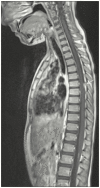A 7-Year-Old Child With Headaches and Prolonged Fever Associated With Oral and Nail Lesions
- PMID: 31700940
- PMCID: PMC6825800
- DOI: 10.1093/ofid/ofz229
A 7-Year-Old Child With Headaches and Prolonged Fever Associated With Oral and Nail Lesions
Abstract
A 7-year-old child of Turkish origin presented with headache and vomiting in the context of prolonged fever of unknown source. At examination, oral candidiasis and chronic onychomycosis were noted. A Candida meningoencephalitis was diagnosed and intravenous Amphotericin B liposomal was given during 6 months relayed by oral Fluconazole after regression of CNS lesions was observed on MRI. A complete immune evaluation was performed, and genetic analysis detected homozygous CARD9 mutation. CARD9 deficiency have been associated with invasive candidiasis in otherwise healthy patients. Culture of the cerebrospinal fluid grew for multisensitive Candida albicans. Brain magnetic resonance (MRI) showed the presence of focal lesions in the left caudate nucleus and in the right cerebellar hemisphere. Medullar MRI showed diffuse meningeal nodular lesions. Treatment with intravenous amphotericin B liposomal was given during 6 months relayed by oral fluconazole after regression of CNS lesions was observed on MRI. A complete immune evaluation was performed and genetic analysis detected a homozygous CARD9 mutation. CARD9 deficiency have been associated with invasive candidiasis in otherwise healthy patients.
Keywords: CARD9 deficiency; chronic mucocutaneous candidiasis; eosinophilic meningitis; meningoencephalitis.
© The Author(s) 2019. Published by Oxford University Press on behalf of Infectious Diseases Society of America. All rights reserved. For permissions, please e-mail: journals.permissions@oup.com.
Figures



References
-
- Roth S, Ruland J. Caspase recruitment domain-containing protein 9 signaling in innate immunity and inflammation. Trends Immunol 2013; 34:243–50. - PubMed

